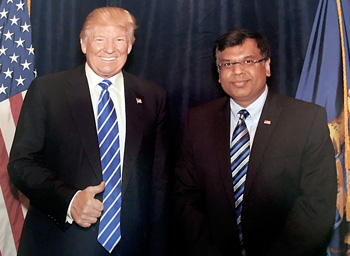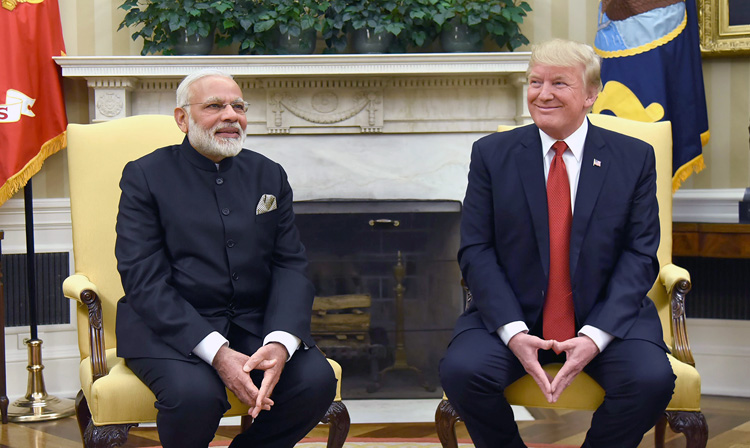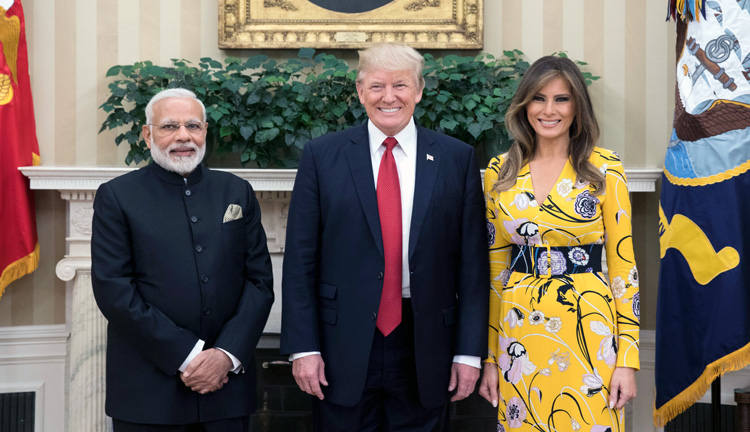INDIAN ARMED FORCES CHIEFS ON
OUR RELENTLESS AND FOCUSED PUBLISHING EFFORTS

SP Guide Publications puts forth a well compiled articulation of issues, pursuits and accomplishments of the Indian Army, over the years

I am confident that SP Guide Publications would continue to inform, inspire and influence.

My compliments to SP Guide Publications for informative and credible reportage on contemporary aerospace issues over the past six decades.
Regional challenges driving Indo-US relations
Both countries have discovered common ground and shared concerns, which have propelled them towards discarding old mistrusts and misconceptions, and adopting methods to establish renewed faith and confidence in each other

From a neutral standpoint, the relations between the US and India have always been influenced by the regional hegemonies of South-East Asia. While the US has sought to protect and assert its influence in the region since the early 1950s to contain the spread of Communism, India has constructed its global perspectives built around the more immediate threats across its borders from Pakistan and China. However, since the demise of the Soviet era, the rapid intermingling of economies built on fast flowing trade, and the emergence of China has added new constructs to the US-India equation, albeit with new challenges. Since the dawn of the new millennium, both countries have discovered common ground and shared concerns, which have propelled them towards discarding old mistrusts and misconceptions, and adopting methods to establish renewed faith and confidence in each other.
The increased frequency of exchanging visits in the recent past by the respective Heads of State and top government officials signals the intent from both sides.
The increased frequency of exchanging visits in the recent past by the respective Heads of State and top government officials signals the intent from both sides. The US interest in the region is only magnified by its rising concerns over China’s purposes and North Korean military ventures. Looking at India as a stabilizing force, US think-tanks have sounded an ‘Engage India’ clarion. The Diplomat recently reported that, “US Secretary of Defence Ashton Carter’s visit to India coincided with the statement by Vice Admiral Joseph P. Aucoin, Commander, US Seventh Fleet, that the US will look at keeping the sea lanes of communication open and also keep a check on North Korea.” Aucoin stated, “The best and the brightest are being shifted to this part of the world. Almost 60 percent of our submarines are in the Indo-Asia-Pacific region. Within the next couple of years, 60 percent of our surface ships will be here too... North Korea is a threat. Our number one concern is to protect Japan, South Korea and our country.”

Ashton Carter, while as Under Secretary of Defence for Acquisition, Technology and Logistics, had managed to convince the Indians for the Defence Technology and Trade Initiative (DTTI) in 2012. During his visit in June 2015, both the countries signed the Framework for the US-India Defence Relationship. Carter met the then Defence Minister Parrikar four times in the space of a single year. Under the aegis of DTTI, the US-India defence collaboration initiative oversaw the emergence of various joint working groups. The Jet Engine Technology Joint Working Group (JETJWG) and the Joint Working Group on Aircraft Carrier Technology Cooperation (JWGACTC) allowed Indian officials at critical positions to engage directly. Parrikar and Carter also initiated two new DTTI pathfinder projects on Digital Helmet Mounted Displays and the Joint Biological Tactical Detection System, during the progress review of DTTI while agreeing to cooperate in more avenues. The US Embassy issued a statement to this effect, “They agreed to work towards greater cooperation in fields of cutting-edge defence technologies, including deepening consultations on aircraft carrier design and operations, and jet engine technology. They noted the understanding reached to conclude an information exchange annex (IEA) to enhance data and information sharing specific to aircraft carriers.”
The two sides also shared a joint statement regarding maintenance of freedom of navigation and over flight in the IOR, including the South China Sea, and working towards establishing a rules-based order and regional security architecture in the Asia-Pacific and Indian Ocean
Under the DTTI arrangement, both sides have mutually agreed to extend collaboration in littoral maritime security and Maritime Domain Awareness (MDA). This arrangement also includes a “white shipping agreement” for data sharing on commercial shipping traffic in the Indian Ocean Region (IOR), explore procedures to develop joint working groups on submarine safety and anti-submarine warfare and further their partnership at an international level. Importantly, the two sides also shared a joint statement regarding maintenance of freedom of navigation and over flight in the IOR, including the South China Sea, and working towards establishing a rules-based order and regional security architecture in the Asia-Pacific and Indian Ocean. Many other project agreements in the area of science and technology were also concluded.

In order to fruitfully gain from the recent military - diplomatic exchanges with India, the US commissioned the Logistics Support Agreement (LSA) as part of military cooperation, under the umbrella of the Communication Inter-operability and Security Memorandum of Agreement (CISMOA) on transfer of technology, and the Basic Exchange and Cooperation Agreement (BECA) for sharing geospatial intelligence - mapping data and imagery. This effort has been on for the past decade and on the lips of every Indo-American inter-government meet.
There are also various realities that have emerged as truths from the ashes of the political burn out over Syria, North Korea and the Chinese angle. There is no denying that the Chinese-Pakistan-North Korea nuclear axis poses the most potent threat to peace in the modern world. Thomas Reed, a former US Air Force Secretary, addressed this in his book ‘The Nuclear Express: A Political History of the Bomb and its Proliferation’, that China had deliberately proliferated nuclear technology to unstable regimes, particularly Pakistan. He stated to US News that under Deng Xiaoping, China decided to proliferate nuclear technology to communists and radical Muslims in the third world based on the strategy that if the west started getting nuked by Muslim terrorists or another communist country without Chinese fingerprints, it would be good for China. Lately, 60 percent of US Naval assets are being relocated to Asia-Pacific, since China has been demonstrating aggressive expansionist intentions to control and blockade the South China Sea, with the ultimate objective to position SSBNs in the Pacific via the South China Sea.
Lately, 60 percent of US Naval assets are being relocated to Asia-Pacific, since China has been demonstrating aggressive expansionist intentions to control and blockade the South China Sea, with the ultimate objective to position SSBNs in the Pacific via the South China Sea
To rebut the rhetoric, the US Asia-Pacific Rebalance should also focus on the China-Pakistani nexus stretching through Gwadar, albeit threatening both India and Afghanistan.
Though this may be a late starter, but from the Indian standpoint, there are many apprehensions yet to be addressed. Continuing the agendas of past US Governments, Ashton Carter brought up the “US Rebalance to Asia and the Pacific” policy and India’s recent ‘Act East’ policy. However, it needs to said that while the US dialogue reiterates China and North Korea; India’s strategic anxieties, concentrated on her western and north-western flanks are less focused upon. The Trump administrations recent crackdown on the Pakistani terrorist factions and acknowledgement of state support to regional subversive organisations signals the long-expected turn-around. This is probably the first of many confidence - building measures which will strengthen the Indo-American strategic partnership. Secretary Mattis’s meetings with the Indian top echelons in the US and his recent outstanding visit to India will surely address these concerns.
Yet another reality that both the countries have to contend with are optimistic agreements being let down by bureaucracy on both sides. The DTTI announcements pronounced no holds barred cooperation by diplomats on both sides, but nothing substantial has been achieved yet. Equipment sought through the Foreign Military Sales (FMS) channel is still to materialize to its fullest potential. On the Indian side, the Ministry of Defence will have to ensure that acquisition cases are progressed rapidly. The issue of the Indian MoD Defence Procurement Procedure (DPP) 2016 after years of deliberations needs to address standards for choosing strategic partner.
The spark in Indo-American relations today is the rapport between the two charismatic heads of state. After speculations at various levels by US political analysts that India was low priority for the Trump administration, further edified by the delay in the first meeting (five months), the status quo today is anything but. PM Modi’s efforts with the Obama administration, having invested enormous political capital and effort over the last three years, were assuaged by the high level of official and personal interactions between the two leaders. Almost all political pundits have termed PM Modi’s visit as an unqualified success. Numerous substantial decisions were taken during the visit. The major takeaway in functional terms was the public rebuke to Pakistan and the declaration of Syed Salahuddin (the leader the Kashmiri militant outfit Hizb-ul-Mujahideen) as a Specially Designated Global Terrorist. Further, Pakistan has been mentioned repeatedly in the Joint Statement issued at the end of the visit, to ensure that its territory is not used to launch terror strikes against other countries, and to expeditiously bring to justice the perpetrators of the 26/11 Mumbai, Pathankot, and other cross-border terrorist attacks perpetrated by Pakistan-based groups. The Joint Statement also named terrorist groups such as Lashkar-e-Taiba, Jaish-e-Mohammed and others, and urged the international community to take united, stringent action against them.
Understandably, Defence is a major area of cooperation between India and the US, with the US being the second largest supplier of defence equipment to India, after Russia. The acquisition of Guardian aircraft is high on the immediate agenda. Also, news reports have stated about a possible tie-up between Lockheed Martin and the Tata group to indigenise and manufacture F16 aircraft in India. This will prove to be an important incentive to the ‘Make in India’ initiative and can transform the landscape of the Indian aerospace industry. Trade has also formed an important keystone of this bridge. President Trump, in his Statement to the Press, referred to a fair and reciprocal trading partnership between the two countries. In a response to Trump’s worries about creating jobs in US, PM Modi mentioned in an op-ed in the Wall Street Journal (WSJ), that Indian investments totalling USD 15 billion in US will create jobs in 35 US States, including the states from where President Trump received massive support in his election campaign. Both sides discussed the sale of approximately 100 civil airliners to an Indian airline, export of natural gas, enhancing bilateral partnership on issues including Afghanistan, North Korea, Middle East, Pakistan, Indo-Pacific Region, India's membership in export control agreements and UN Security Council, cyber space, Malabar naval exercises, reaffirmation of India's designation as a Major Defence Partner, support to United States to join as an Observer in the Indian Ocean Naval Symposium, etc.
The trial-by-fire of the commitments promised by the two countries can be assessed only by positive actions. Good intentions aside, it is prime time for both sides to start delivering on the many fronts opened. With strong leaderships and robust economies, both the countries have only to overcome their own inertias and set the ball rolling for fostering peace, harmony, and financial wellbeing in the Indo-Pacific.





